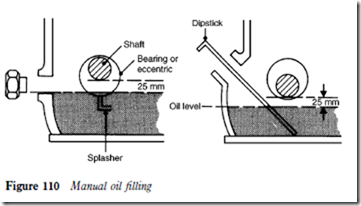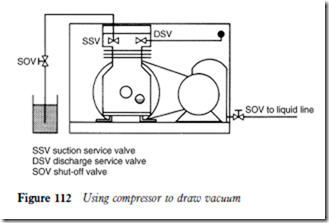Oil addition and removal
When the system has been fully charged and the controls set, the equipment is operated at average evaporating conditions. The compressor oil level must then be checked.
All new compressors receive an operating oil charge during manufacture, but this does not allow for oil trapped within components and controls and circulating with the refrigerant. This is the reason why oil levels must be checked and oil added to the system at the time of installation or commissioning.
Add ngol
Only the make and grade of oil specified by the manufacturer of the compressor must be used. Oils have special characteristics for pressure, temperature and load conditions, especially those used for low temperature applications.
The larger compressors will have oil-level-indicating sight glasses located in the crankcase. If compressors are used in parallel, there is sometimes a sight glass in the middle of the oil equalizer line. During operation the oil level in the crankcase may well fluctuate. It is generally accepted that a level maintained at one-third to one-half of the way up the sight glass is satisfactory.
Before any oil is added, the system must be fully charged. This is most important when the compressor is located above the level of the evaporator. Oil levels should be rechecked after a system has completed its initial pull- down, or has operated for at least two hours. If a sight glass indicates foaming, ensure that this is not the result of absorbed refrigerant. Systems prone to this condition will probably be fitted with crankcase heaters.
Oil may be added to the crankcase of larger compressors simply by pumping down and reducing the crankcase pressure to enable oil to be poured when the filler cap has been removed. However, filler holes tend to be small on some compressors and an oil pump may be used.
Too much oil in a crankcase can cause damage to a compressor by creating a dynamic pressure during operation.
The procedures for adding oil will obviously vary according to the type of compressor.
Charging pump and simple filling
The oil charging pump is similar to a cycle pump and needs no explanation. The correct oil level must be attained, and reference should be made to the manufacturer’s data.
Sometimes it suffices to add oil to a compressor until it runs out of the filler hole; a dipstick will be required for other types. In each instance the oil level will be such that it is approximately 25 mm (1 inch) below the crankshaft so that bearings or splashers immerse in the oil as the shaft rotates (Figure 110).
When a compressor has a sight glass it is a simple task to add oil. The procedure is as follows (Figure 111):
1 Pump down the system to reduce the pressure in the crankcase to 0.1 bar (1 psig) and front seat both suction and discharge service valves.
2 Remove the oil filler plug and fit a charging line incorporating a shut-off valve and an adaptor to insert into the filler hole.
3 Place the free end of the charging line into a container of clean and uncontaminated oil from a sealed can. Crack off the suction service valve from the front seat position and raise the crankcase pressure to 0.1 bar.
Open the shut-off valve slowly and purge the charging line through the oil in the container. Front seat the suction service valve.
4 Connect a vacuum pump to the gauge union of the suction service valve.
5 Switch on the vacuum pump and reduce the pressure in the crankcase to slightly below atmospheric, allowing the oil to be drawn in until the correct level is reached.
6 Stop the vacuum pump, crack off the suction service valve from the front seat position, purge oil from the charging line and close the shut-off valve. Then front seat the suction service valve.
7 Remove the charging line and replace the oil filler plug.
8 Fully back seat and crack off both service valves, or set to operating positions.
9 Leak test the compressor.
10 Start the system and allow it to settle down to average operating conditions. Recheck the oil level.
When charging oil, ensure that the charging line is always below the oil level in the container.
Compressor charging
When the compressor design is such that a suction strainer and oil return to the crankcase is featured, oil may be added via the suction service valve gauge union in much the same way as described above but using the compressor to draw a vacuum instead of a vacuum pump (Figure 112).


